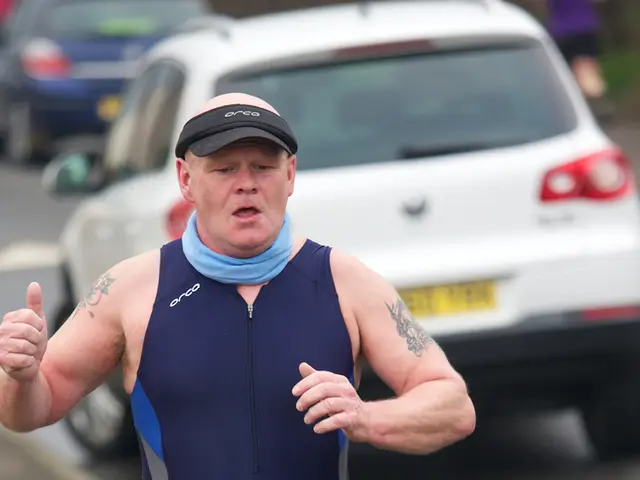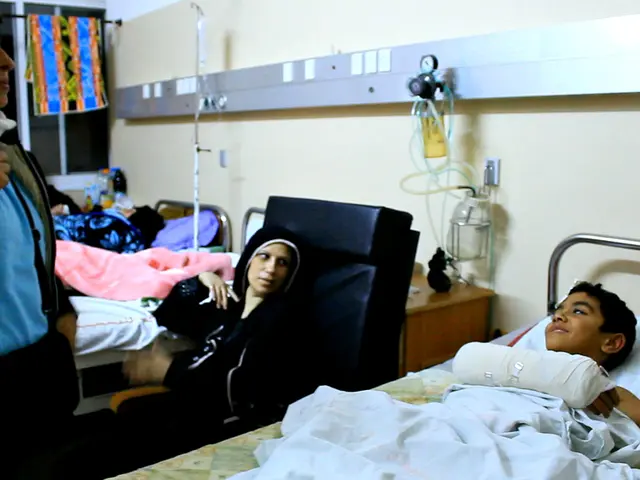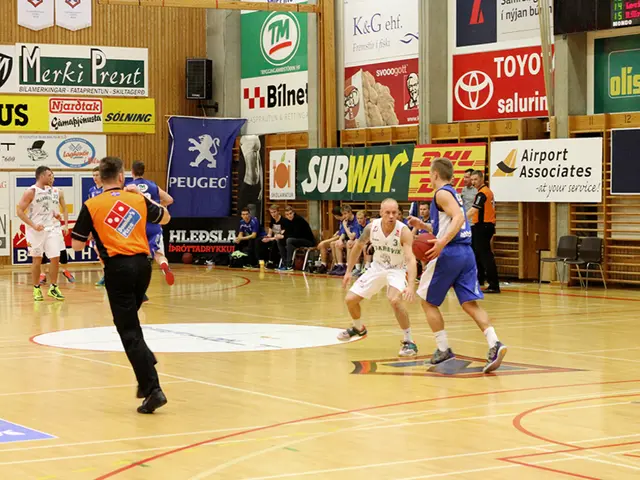Liberation Moment Captured: Image Reveals Nazi Death Train Scene - Liberation snapshot captures poignant scene during Nazi death march
Unfiltered History: The Death Train Liberation - Witnessing the End of War's Horrors as a Few Soldiers Halted the Nazi Train of Terror
by Wade "Blunt" Johnson* ~ 5-ish Min*
Few remember the unsung heroes of World War II, the 743rd Tank Battalion. While they didn't lead the charge of legendary divisions like the 82nd Airborne or the 1st Infantry, they were right there at D-Day's start, later taking on formidable fights for the Siegfried Line and the Battle of the Bulge. During this battle, they halted the advance of the infamous 1st SS Panzer Division, the "Leibstandarte."
The Faces of Freedom
As the war neared its end, one of their officers, Major Clarence "Benny" Benjamin, snapped one of World War II's most powerful images. It depicted women and children exiting a Nazi death train. The shot captured the disbelief of a woman, who, with tears of joy, couldn't quite believe her eyes, only now, within the presence of US soldiers, finally easing months of tension. Hope and relief consumed her face.
George "Gus" C. Gross, a tank commander, recalled a similar moment: "There stood a young girl, perhaps fifteen, her face so thin that her eyes seemed monstrous, but that smile... it was as if she'd found a glimmer of hope despite everything." The photo was later displayed in exhibits about concentration camp liberations and serves as a symbol of humanity amidst wartime devastation.
The liberation of Auschwitz by the Red Army, the arrival of US troops in Dachau, and that of the British in Bergen-Belsen are historically more significant events. Yet, no photo encapsulates the moment of liberation as potently as this one from near Magdeburg. About 2,500 individuals were herded into the wagons. They were survivors of the extermination camp Bergen-Belsen whose train, starving, disease-ridden, and grossly overcrowded, aimlessly travelled through war-torn landscapes.
The Rage of the Killing Machine
As Germany's Reich crumbled in mid-April 1945, the killing machine continued its fury. Prisoners were shot, or transported to keep them from being freed by the Allies.
These individuals were among Bergen-Belsen's "privileged" prisoners, chosen by the Nazis for a planned prisoner exchange with the Allies. The train wandered with no supplies through Germany still under Nazi control. When it reached my limits, the commander is said to have received instructions to drown all inmates during a planned bridge explosion in the Elbe. However, survivors reported that the commander, an SS officer named Max Schmidt, had no intention of killing the Jews in the train but was waiting for an opportunity to escape with them, possibly surrendering to the Allies.
Forgotten Heroes
This moment of liberation was mostly forgotten. It wasn't until 2001 when tank commander Carrol Walsh reminisced about his battalion's missions in an interview. He spoke of battles and comrades lost. It was only by chance that he mentioned the liberation of the train. "We were driving along this road when suddenly we saw these people by the side of the road. They looked like skeletons, so frail. I initially thought they were refugees, but then I saw the wagons. It was a shock to realize that these were prisoners from a concentration camp," Walsh said. This interview sparked further research with survivors and several book publications.
We found ourselves on a narrow road, with trees lining it, leading to a railway siding in a wooded ravine near the Elbe. There, Major Benjamin and his patrol encountered around 200 emaciated figures along the roadside on April 13, 1945. Benjamin, a seasoned officer from Ohio, was deeply affected by the encounter and kept the photo for the rest of his life. Artillery fire could still be heard in the background. The soldiers suspected something was amiss.
Walsh recalled, "People approached us, laughing hysterically as if they couldn't believe it. I'll never forget an older man taking my hand and kissing it. He didn't speak English, but his eyes said it all." Rappaport, then 16, recounted, "I thought I was dreaming, I couldn't believe we were saved."
Near the road stood the old freight wagons on the siding – a pitiful, desperate camp full of people.
Memories of the Liberator
In 2001, tank commander George C. Gross reminisced about the events: "On Friday, April 13, 1945, I commanded a light tank in a column of the 743rd Tank Battalion and the 30th Infantry Division... The major led our two tanks, each carrying several infantrymen of the 30th Infantry Division on their decks, down a narrow road until we reached a valley. There was a small station with a colorful array of passenger and freight wagons on a siding. A mass of people sat or lay there, who had not yet noticed our presence." It was a liberation without firing, as the Germans had fled.
"There must have been guards, but they had either disappeared before or at our arrival, as I don't remember any gunfight," Gross said. He also remembered the woman's photo: "It shows a woman in the foreground with her arms outstretched, an expression of surprise and joy on her face as she rushes towards us."
The soldiers aimed to help as much as possible, but the patrol with two light tanks had no provisions for 2500 people. Ariela Rojek, a survivor, recalled, "The soldiers gave us chocolate and bread, but many were too weak to eat. I remember a soldier crying as he lifted children from the wagons. We were no longer strangers to them - they saw us as people."
Gross remembered sixteen dead being carried out of the wagons. The soldiers positioned their tanks to ostentatiously place the train under the protection of the US Army. Then, the liberated gathered before the soldiers. They stood tall, held their heads high, and formally presented themselves in an unusual ceremony. They had regained their dignity, now recognized as human beings.
Michael Hirsch, then seven, recounted, "I remember the tanks and the soldiers with stars on their uniforms. My mother held me tight and whispered, 'We are free.' It was the first time in years I saw her smile." Gross remembered a group of girls, who were eerily thin, their cheeks hollow, their eyes huge, having seen much terror and hardship, yet they wore a smile that melted his heart.
Sources:
- A Train Near Magdeburg – The Holocaust, the Survivors, and the American Soldiers Who Saved Them by Matthew Rozell*
- End of War
- World War II
Enrichment Data:
General: This 1945 death train liberation near Magdeburg by the 743rd Tank Battalion stands as a touching wartime episode, shedding light on the horrors that avoided untold suffering and death for hundreds of Holocaust survivors. This unknown transport, originating from Bergen-Belsen's Sternlager, was part of the camp's forced evacuation in the chaotic days leading to Nazi defeat [5].
On April 13, 1945, American forces advancing into Nazi territories encountered the "stranded train" near Farsleben, close to Magdeburg. The prisoners trapped inside had suffered atrocious conditions during forced death marches and transport, enduring extreme malnutrition, exhaustion, and disease [3].
The Nazis planned a devastating end for the individuals on this train – driving it onto a damaged bridge to kill everyone aboard [4]. However, the American 743rd Tank Battalion thwarted their plans, freeing hundreds of weakened prisoners from almost certain doom [1][2].
Major Clarence L. Benjamin of the 743rd took an iconic picture capturing the moment of liberation as the soldiers arrived [1][4]. Survivors recall emotional relief and tears when they saw the American tanks, marking a powerful moment they realized they were safe and the war had ended for them [1][2].
This liberation narrative was forgotten for decades but has since been revisited and documented, including in the book "A Train Near Magdeburg," which collects survivors' testimonies and accounts from the liberating soldiers themselves [1][2]. The episode symbolizes not only the darkest days of the Holocaust but also the exceptional human resilience and hope amid the evil of the Nazi death trains.
- Soldiers from the 743rd Tank Battalion, often overlooked heroes of World War II, played a significant role in halting the advance of the 1st SS Panzer Division during the Battle of the Bulge, and later liberated a death train carrying remnants of Bergen-Belsen survivors.
- Major Clarence "Benny" Benjamin, an officer from the 743rd Tank Battalion, captured a powerful image of the end of the Second World War - women and children exiting the Nazi death train, their faces filled with disbelief, relief, and hope, symbolizing humanity amidst wartime devastation.
- The liberation of Auschwitz, Dachau, and Bergen-Belsen are historically more significant events; however, the image taken by Major Benjamin near Magdeburg encapsulates the moment of liberation more poignantly, conveying the feelings of hope, relief, and freedom experienced by the survivors.
- As the end of the war approached, the 743rd Tank Battalion, while not among the most recognized divisions, played a vital role in bringing an end to the horrors of the concentration camps, halting the advance of the killing machine, and liberating remnants of humanity amidst the chaos and devastation of the Second World War.









